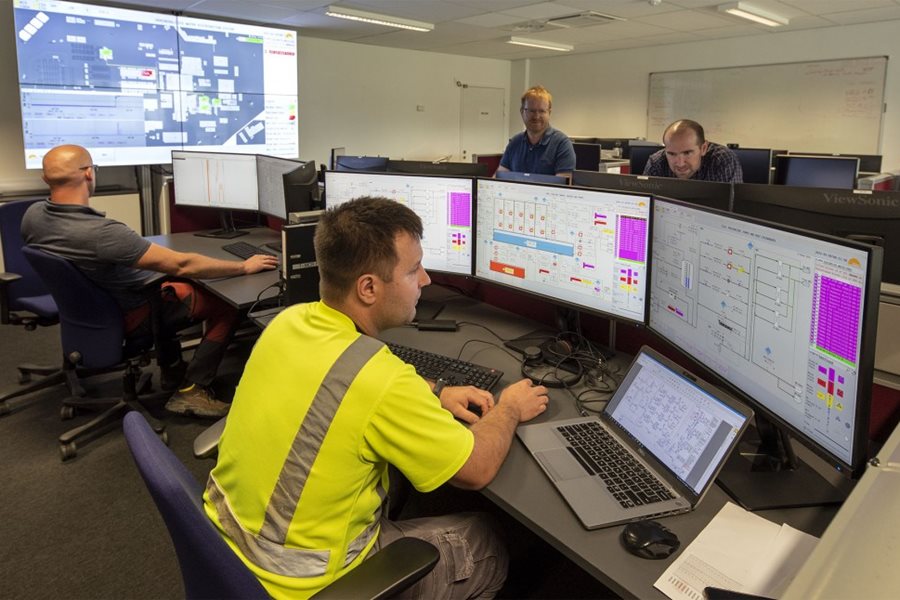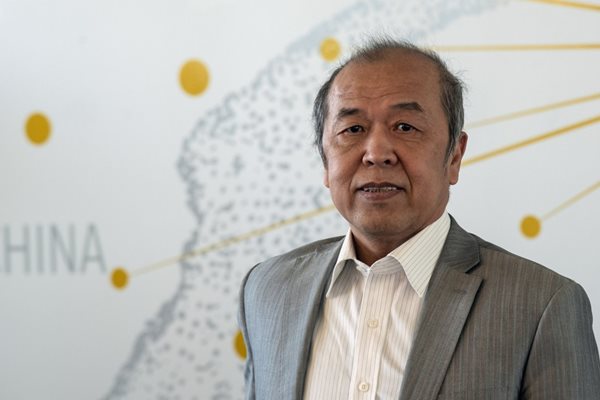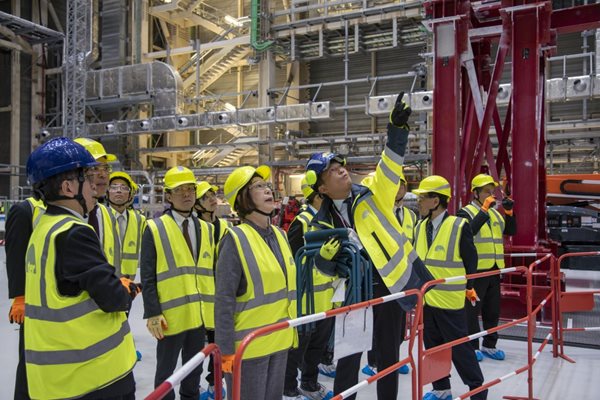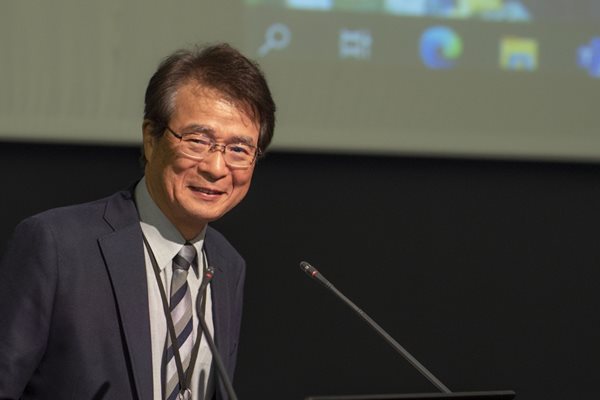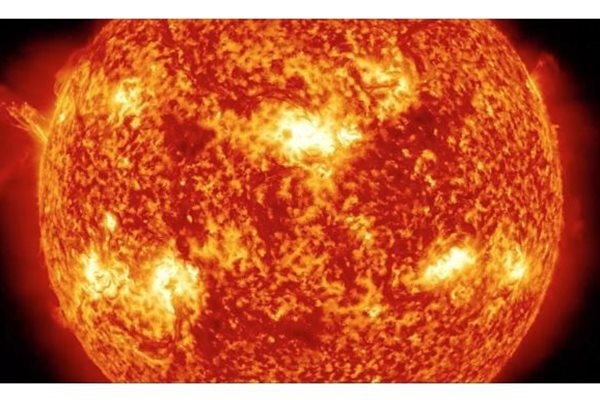
you're currently reading the news digest published from 24 Apr 2023 to 09 May 2023
featured4
of-interest3
press15
featured
Temporary control rooms | Re-centralization has started
A network of temporary control rooms was set up to support commissioning and operation of systems before the main control room became available. Teams are now working to re-centralize some of the distributed functions. Deployment of temporary control rooms began in 2018 as the need arose at different locations around the site. They support local testing and commissioning—and offer the added advantage of being close to the equipment being controlled. This proximity allows operators to listen directly to what is happening with nearby equipment, which is often very helpful during the first few rounds of commissioning. Staged integration and commissioning started at the electrical substation, then moved to the cooling water and heat rejection area at the opposite end of the platform. To network the temporary control rooms in each of these areas, I&C experts installed temporary fibre connections to the Headquarters building, where the technical infrastructure and the temporary main control room (T-MCR) are hosted while the Control Building is being readied. The result was two separate network legs. Just over a year ago, a big improvement was made by connecting the two legs to one another to provide resilience. In large building projects, cables are at risk of being cut by accident; the connection between the two legs provides an alternative path over which data can be transmitted in the case of failure along one leg. 'We are now at a point where we can simplify the architecture and prepare for a more centralized control system by taking back some of the functions that were distributed to the temporary control rooms,' says Bertrand Bauvir, leader of ITER's Central Control Integration Section. 'We started at the end of last year.' Work is now underway to decommission the temporary control rooms and migrate the functionality to a central location—first to the T-MCR and then, in 2024, to the ITER Control Building, where they will reside for the lifetime of ITER. But select temporary control rooms are expected to maintain a vital role for about two more years. The human-machine interface remains the same The same human-machine interface that was used in each of the temporary control rooms has been re-implemented in the T-MCR and will remain unchanged when moved to its ultimate home in the ITER Control Room. The operator terminals are also configured in the same way in each of the three settings; however, access control may be different. 'We have both role-based and condition-based access control,' says Bauvir. 'For example, not everybody is licensed to operate 400 kilovolt equipment connected to the French grid. Role-based access control means only a subset of the users of the control system—those who are licensed to operate a part of the machine—can have access.' 'A good example of condition-based access control is the cryoplant, which is currently in commissioning by a number of different teams. We restricted the operability of the cryoplant equipment to just the temporary control room in that building. You can connect from any other control room, and you could monitor and observe any of the measurement points from anywhere in the current plant, but you could not take operational control.' Eventually, all operations will be performed centrally from the ITER Control Building. But as ITER is now in staged commissioning, which describes the parallel commissioning of different plant systems by different groups, select temporary control rooms still have an essential role in allowing different teams to work independently and operate very close to the equipment in question.
Deputy Director-General | Luo Delong, Corporate
Many years later, when the Ministry of Science and Technology assigned him to the ITER Project, Luo Delong was to remember the day when, as a young boy, he read about a 'man-made Sun' in a Chinese newspaper. The small piece 'caught [his] imagination' but was soon forgotten; in the days when Delong was growing up there were more urgent issues. Developing the country's industrial production was one, which explains why the boy's parents, both mechanical engineers, were away most of the time, leaving him to the care of grandparents. Delong's grandfather happened to be a mechanic and, in such a family environment, the young boy developed a taste for 'dismantling and rebuilding things.' In another time and place, Delong, who took office as ITER Organization Deputy Director-General—Corporate on 1 April, might have entered a career like his parents' and grandfather's. But circumstances decided otherwise. In middle- and high-school, Delong worked hard, enjoyed studying and got good grades. When he turned 16, despite his young age, one of his teachers felt he was ready for college—but his protective grandparents preferred to have him wait another year. He took the entrance exam and passed it, and a few years later at age 21 Delong obtained his Bachelor degree in mechanical engineering and was offered a job by the government. 'We had few job options at the time; I chose science and technology and began working for a library affiliated with the Ministry of Science and Technology. My job consisted of writing abstracts in Chinese and English for books destined to students and the public, a great opportunity to acquire culture and knowledge in all kinds of different fields.' China, like all developing countries at the time, needed technical and administrative elites. A few years into his library job, Delong was selected by a United Nations development program that aimed to train young people from around the world and expose them to an international environment. After two years at the University of the Philippines, having improved his command of English and earned a Master's degree in library science, the Ministry called him back. He was needed in the Department of International Cooperation. Thus began Delong's lifetime involvement and commitment to technical and scientific collaboration among nations. From his original assignment to a three-year mission as science attaché at the Chinese Embassy in Oslo, Norway, from his responsibility for the Ministry's relationships with international organizations to his appointment to lead China's involvement in ITER ... he developed a unique talent to motivate, negotiate and, whenever needed, appease. Long before he was appointed Deputy Director-General—Corporate of the ITER Organization, Luo Delong was a familiar presence within the ITER and fusion communities. Beginning with China's bid to join the project in late 2002, he took part in each and every negotiation and expert meeting prior to the establishment of the ITER Organization. He built the Chinese Domestic Agency 'from scratch,' joined the ITER Management Advisory Committee (MAC), and eventually chaired the ITER Council (2020-2021). It is an understatement to say that Delong knows the project inside and out—its strengths and vulnerabilities, 'the pros and cons' of its organizational structure and, most important, 'the crucial nature of the present moment.' 'There are lots of issues to be addressed,' says Delong. Covid and 'the rest' (meaning the non-conformities in key components that need repair) are causing delays that governments may find hard to accept. 'In terms of schedule, we have made promises that were difficult to fulfil. Now we need to work on retaining and rebuilding confidence among our stakeholders.' To the new Deputy Director-General—Corporate, 'ITER is an engineering organization' that, gradually, has become more and more bureaucratic. 'The files piling up, thicker and thicker, the multiplication of meetings ... this is not ideal for the efficiency of an engineering project . At this stage of ITER history, we need to adapt our project culture.' Outside ITER, the environment has changed also. The recent emergence of fusion startups and the massive investment from private money to realize fusion in record time, whether well founded or not, has changed the way public opinion views fusion and its flagship project. 'There are 'decadal plans' everywhere. We have to take this into consideration in order not to be perceived as irrelevant.' In a career that spans more than 40 years and has included broad administrative responsibilities, the management of international collaborations, and involvement in constructing and operating major scientific installations (the HL-2A, HL-2M and EAST tokamaks), Delong feels that the challenges that ITER is presently facing fall into his 'core competence.' But he knows from experience that 'the journey may be tough when one walks alone, but gets easier when people walk together.' And that is exactly what he intends to establish: a collective dynamic within the ITER Organization.
Visit | Japanese MEXT Minister tours the installation
In Japan, a MEXT Minister has a lot on his or her plate: the extensive Ministry is a huge administrative machine whose purview includes education, culture, sport, and science and technology with, as part of the latter category, oversight responsibility for Japan's participation in ITER. Several times over the past 13 years, MEXT ministers have come to the ITER site to tour the installation and meet with project management. Minister Tatsuo Kawabata came in 2010, and two of his successors—Hirofumi Hirano in 2012 and Yoshimasa Hayashi in 2017—followed suit. The present MEXT Minister, Keiko Nagaoka, first visited ITER in 2019 when she was the State Minister for Technology, a position that ranks second to Minister. She was back on Wednesday 3 May 2023 with a large party of deputies and advisors. Guided by ITER Deputy Director-General (Science and Technology) Yutaka Kamada and Acting Head of the Office of the Director-General Takayoshi Omae, she toured the cryoplant, the Assembly Hall and the machine assembly pit before holding a formal meeting with ITER Organization Director-General Pietro Barabaschi and senior management.
Farewell | Eisuke Tada's ITER odyssey
The picture is part of ITER history: taken in February 2006 in front of the ITER Joint Work Site office building in Cadarache, France, it features the 'Original Six,'—the small team that was to grow over the years to staff the ITER Organization, and that numbers nearly 1,100 today. Eisuke Tada was one of them, both a pioneer in the territory that had been selected for the construction of the ITER installation and a veteran, having devoted almost two decades to the project and even longer to international cooperation in fusion. Akko Maas, who serves as Science Coordination Officer in the Office of the Director-General, was also in that original picture. On 27 April 2023, when the ITER community held a farewell event on the occasion of Eisuke Tada's retirement and return to Japan, he hailed 'the gentle soul, who was firm when needed,' and a 'highly technically sound' colleague who was 'truly committed to the ITER machine throughout all his different roles.' ITER Director-General Pietro Barabaschi, whose path often crossed that of Eisuke Tada over the past three decades, also had many stories and remembrances to share. But what stood out beyond anecdotes was gratitude for Eisuke Tada's unflinching dedication and commitment, especially during the 'difficult period' when, following the untimely passing of former Director-General Bernard Bigot, he assumed the interim role of Director-General of the ITER Organization. Eisuke Tada's odyssey in the realm of fusion—which began in 1978 when, fresh out of university, he joined the Japanese Atomic Energy Research Institute (now the Japanese Atomic Energy Agency)—did not come to an end on 27 April. For the fusion community as a whole, it will be tempting to tap into the knowledge, experience and intimate understanding that Eisuke Tada has accumulated. In a certain way, one never retires from fusion.
of-interest
The ITER Podcast: Episode 3, Season 2
Episode 3 of The ITER World, ITER's second podcast miniseries, is now available. "Falling for Fusion" features interviews with two young fusion enthusiasts who explain how they came to find out about fusion science and technology, how they joined the effort to increase the visibility of this very active field of research, and where they think fusion fits into the future. Listen to the latest episode with host Kruti Mawani Fayot directly on the ITER website or through the following channels: Amazon Music, Apple Podcasts, Google Podcasts, PodBean, Spotify, and Tune In. Visit the podcast page of the ITER website for all episodes.
EUROfusion Engineering Grants
The European Consortium for the Development of Fusion Energy, EUROfusion, has launched a call for 2024 EUROfusion Engineering Grants. These grants provide funding for up to twenty outstanding early-career engineers to conduct research projects starting in the first half of 2024. The EUROfusion grant will cover their salaries under the EUROfusion funding rules as well as contribute to their research activities and missions for the duration of two years. EUROfusion encourages young engineers who are passionate about fusion research to apply for this opportunity. To be eligible, candidates must currently hold a Master's degree in engineering and have finished their degree within six years preceding the submission deadline. Interested candidates should jointly prepare their application with a EUROfusion consortium member or affiliated entity, who will submit the application and offer to employ the candidate for the proposed duration of the project. Interested candidates are invited to attend the EUROfusion Training and Education Office's Q&A Information Session on Wednesday, 24 May 2023, at 14.00 CEST (connection details can be found on the EUROfusion wiki pages or requested by emailing EEG24application@euro-fusion.org). The submission deadline is 5 June 2023. For all information, see these pages.
Introductory plasma physics course
During the weeks of 5 to 15 June 2023, the Princeton Plasma Physics Laboratory (PPPL) will host a intensive virtual course on plasma physics and fusion energy sciences, taught by world-renowned scientists from various US and international institutions. The course is targeted at undergraduate students interested in plasma physics and fusion energy science and is open to the public at large.Registration is free and participants who attend the full course will receive a certificate of completion.The introductory course will be fully conducted via Zoom, and in half-day sessions (12PM-5PM EST) in order to accomodate various time zones.The content will reflect the broad research under the fusion energy sciences and plasma physics umbrella, including discovery plasma sciences, magnetic fusion energy, fusion materials and technology, and high energy density plasmas.See all information here.
